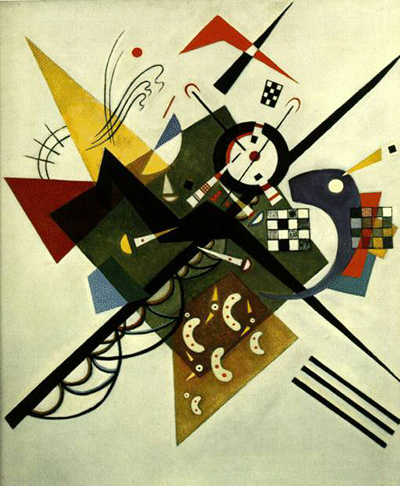On White II, is an excellent painting by the Russian artist Wassily Kandinsky, and was created in 1923. This early example of abstract art measuring 98cm x 105cm is said to be Kandinsky’s most famous painting.
Kandinsky used an array of geometric shapes and lines in a colourful and riotous contemporary display, prompting many artists to imitate his style. On White II, is located at Georges Pompidou Centre, Paris, France.
As the title suggests, white is predominant in this painting, including the background. Kandinsky used white to represent life, peace and silence. The majority of the geometric shapes are presented in a variety of colours, reflecting the artist’s love for the free expression of inner emotions. Striking through the kaleidoscope of shapes and colours are bold, spiked barbs in black, representing non-existence and death.
Kandinsky liked to paint while listening to music, and On White II, is his interpretation of the music, as created by his inner consciousness. The abstract and possibly mesmerising display of shapes and colours can be compared with the complexity of a musical composition.
As one of the forefathers of abstract, modern art Kandinsky used the graphic interrelation between colour, shape, and form to stimulate the mind of the viewer and open the possibility for profound transcendental expression. Painting, to Kandinsky, was a means to convey a deep sense of spirituality and human emotion through the use of abstract visual forms transcending all conventional boundaries.
Wassily Kandinsky was born in Moscow in 1866 to music-loving parents. His father; Vasily Silvestrovich Kandinsky was a tea merchant. His parents divorced when Wassily was about five years old, and he moved to Odessa to live with his aunt. He learned to play piano and cello at grammar school. He was tutored in the art of drawing, with a coach. Even as a youngster Wassily displayed a well-developed perception in the use of colour and in his belief that each colour has a mysterious “life”.
In 1886, Kandinsky followed his family’s wishes by entering the University of Moscow to study law. He graduated with honours and earned a fieldwork scholarship to the Vologda province to study their traditional criminal system. Kandinsky married Anna Chimyakina in 1892 and started work at the Moscow Faculty of Law. As a concession to his art background, he also managed an art-printing works as a sideline.
An abrupt change in his career took place in 1896, triggered by two events: an exhibition by French impressionists in Moscow, including Claude Monet’s Haystacks at Giverny; and hearing Wagner’s Lohengrin at the Bolshoi Theatre. Kandinsky was so moved by these experiences that he abandoned his career in law and moved to Munich, Germany to study art, full time at the Munich Academy of Arts. Starting with current art themes and forms, Kandinsky then began developing his personal theories derived from the mystical study of the relationship between colour and music.
In 1903, Kandinsky met Gabriele Munter, an art student, and moved in with her before divorcing his wife in 1911. The outbreak of World War I affected a return to Russia where Kandinski was influenced by the constructivist movement in art, which consisted of lines, dots and geometric shapes. Another change of partner took place at the age of fifty when Kandinski married the, much younger, Nina Andreevskaya, the daughter of a Russian Army general. They had one child, who sadly died at the age of three. After the revolution, Kandinski applied his energies to government-run educational art programs. He assisted in the creation of Moscow’s Institute of Artistic Culture and the Museum of Pictorial Culture.
After disagreements with other artists over theory, Kandinsky moved to Berlin where he taught at the Bauhaus school and wrote poems and plays. The Nazis shut down the school, after seizing power in 1933. Kandinsky’s art featured, along with other artists work, in “The Degenerate Art Exhibition” in Munich in 1937. But 57 of his works were seized by the Nazis.
Kandinsky and his wife Nina moved to a suburb of Paris in the late 1930s but fled to the Pyrenees when Germany invaded France in 1940. Returning to Paris again, Kandinsky became reclusive when he wasn’t able to sell his paintings which were considered by many to be controversial. He did, however, continue to exhibit until his death in December 1944.




